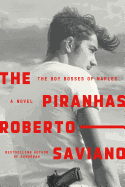
In The Piranhas: The Boy Bosses of Naples, Italian journalist Roberto Saviano (Gomorrah) turns to fiction to look at Neapolitan crime, and focuses on the real-life phenomenon of youth gangs, or paranze, wreaking havoc in the city. The tale is all the more disturbing for its basis in real events.
Fifteen-year-old Nicolas Fiorillo and his friends from the slums of Naples are preoccupied by symbols of wealth and status, online and off, obsessing over shoes and girls. They quickly find themselves enlisted as small-time drug dealers for one of the established gangs operating out of Naples. Nicolas is restless, however, and when a shake-up leaves them without a backer, he decides to start a paranza of his own.
Saviano and his translator, Antony Shugaar, use the nuances of language to reflect on the culture that produces gangs of violent young boys. For example, paranza refers not just to gangs but to the "boats that go out to catch fish through the trickery of light. The new sun is electric... and the fish come looking for it." The boys are seduced by the gangster lifestyle and are alienated from their parents--for them, easy money, drugs and power prove far more attractive than hard work or education.
The Piranhas contains scenes of violence that are shocking not just in their ferocity but for the youth and immaturity of the perpetrators. Saviano paints a portrait of youthful disaffection and misguided priorities, ending in tragedy as daisy chains of violent acts reach their inevitable conclusions. --Hank Stephenson, bookseller, Flyleaf Books, Chapel Hill, N.C.

